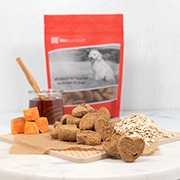 |
Hi ed,
Many dogs are affected by joint pain and yours may be, too. It is common for me to see dogs with joint problems. After all, one in five dogs (or over 11 million dogs) suffer from joint and mobility issues. One such dog is Sweet Lips. My parents own her. Sweet Lips is a 9-year-old yellow lab that was always the life of the party. Sweet Lips was the first to rise and the last one to go to bed. However, things seemed to be changing and my parents noticed that Sweet Lips was avoiding the stairs and she seemed to be less interested in her other furry friends. It just seemed like Sweet Lips was losing her get up and go ... After a quick trip to the veterinarian, it was clear that Sweet Lips needed help to address the problems with her shoulder joint and hips, and my parents were thankful that there are high-quality supplements available that can reduce her pain and improve her mobility. About a month ago - my parents ran out of the supplement - and within a week, Sweet Lips was limping again. She was having trouble getting up and her first few steps were clearly very painful. She no longer wanted to run or play (and she LOVES to swim, fetch and run). Now she is back on her supplement and running around once again. Here is a photo of Sweet Lips swimming this fall - our entire family is so happy to see Sweet Lips back to her old self.  Inflammation or swelling in a joint affects millions of dogs of any age, breed or sex. There are various causes from abnormal bone or joint development to instability of the surrounding ligaments and tendons. If your dog is suffering with joint problems, there are several things you can do to make your dog more comfortable. 1. Consider your flooring. Hardwood, tile and linoleum floors are slippery and it can be difficult for dogs with joint issues to gain secure footing. Placing carpet or area rugs will help secure your dog's footing and prevent an injury from slipping. 2. Massage. Massage can increase flexibility, circulation, and create a general sense of wellness. You can do it yourself or seek a professional animal massage therapist. 3. Weight control. Join issues can certainly be more of a problem for obese pets. Weight loss can be beneficial by helping to reduce the workload on the bones and joints. 4. This formula helps maintain healthy joint cartilage and connective tissue, and to aid in the production of healthy synovial fluid, which lubricates the joints. This supplement features Glucosamine, MSM, sea mussels and hyaluronic acid. Agility Formula is a natural, holistic, multi-action joint support formula containing scientifically-tested ingredients 5. Provide a soft bed. Soft bedding can help support the bones and joints and make your pet more comfortable. This can be especially important in thin dogs in which bony prominences are likely to rub on hard surfaces. There are some beds that are made especially for dogs with arthritis, such as waterbeds and hammock beds. Arthritis and Joint health is an important part of your dog’s overall health care. Ongoing improvements in supplements are helping more dogs stay active and enjoy an enhanced quality of life. By being considerate of your dog's condition and finding ways to keep him more comfortable, you can alleviate pain and ensure a higher quality of living. I hope these suggestions help your dog. |




















